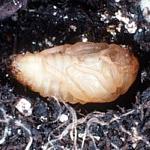Lawn grubs are the larval stage of several beetle species that are turfgrass pests. They are members of the Scarabaeidae family (the scarab beetles). The species in this group of beetles are similar in appearance and habits and are often referred to as white grubs.
Some of the links in this article are affiliate links. This means if you click on the link and purchase the item, I will receive an affiliate commission at no extra cost to you. All opinions remain my own. PLEASE READ MY DISCLOSURE FOR MORE INFORMATION.
Grubs injure lawns as they burrow through the soil feeding on grass roots. Most of the feeding — and damage to grassroots — is done in late summer and into the fall. Much of the root system can be lost where feeding is heavy.
Some adults (such as the Japanese beetle) will do significant damage to ornamental plants as they feed on leaves, fruit and flowers.
Life cycle
Most lawn grubs have a one-year life cycle. The exceptions are the black turfgrass ataenius which has a two-year life cycle and the May or June beetles take three years to complete their life cycle
A one-year cycle starts with adult beetles emerging from the soil in late May, mating and depositing eggs back in the soil. The eggs hatch within a few weeks and the larvae begin their feeding. Most of the heavy feeding and damage is done late summer through the fall. The grubs then move deep into the soil as temperatures drop and overwinter there. Grub feeding continues for a short time March through mid-May before they pupate and emerge as adults. Adult beetles live only a couple of weeks.
May or June beetles do most of their feeding and damage in the second summer of their life cycle. The black turfgrass ataenius is mainly a golf course pest that damages fairways in the summer months.
Species of Lawn Grubs Include:
- Asiatic Garden Beetle
- Japanese Beetle
- Oriental Beetle
- European chafer
- Northern and Southern Masked Chafer
- May or June Beetle (3-year life cycle)
- Green June Beetle
- Black Turfgrass Ataenius (2-year life cycle)






USDA Animal and Plant Health Inspection Service, ‘Managing the Japanese Beetle: A Homeowner’s Handbook’ Public Domain image

USDA Animal and Plant Health Inspection Service, ‘Managing the Japanese Beetle: A Homeowner’s Handbook’ Public Domain image

Symptoms of a Lawn Grub Infestation
Since grubs live in the soil, their activity can go unnoticed until it is too late. Damage can easily be confused as drought stress or dry spots – with grass wilting shortly after rain or watering. Infested lawns will thin, and weaken and then dead patches will appear that can be easily lifted or “peeled off”. Skunks and birds will tear up the lawn looking for grubs to eat.

The mole/grub relationship is often misunderstood. A common remedy for mole activity is…”You have moles, therefore you must have grubs. Kill the grubs and the moles will leave.” Yes, moles will eat grubs. However, earthworms are their preferred entree – grubs are just a side dish. Many insecticides will reduce the earthworm population, sending the moles elsewhere for a bit…but they will return.
Myth Busted! Mole activity is reduced because their main food source – earthworms – has been depleted by insecticides.
So…How do you get rid of moles?
The best and most eco-friendly way to control moles is by trapping.
Adult Beetle Feeding
While all scarabaeid lawn grubs feed on grass roots, the adults have feeding habits that vary with species.
Masked chafer adults don’t feed.
The black turfgrass ataenius eats decaying organic matter and dung.
Japanese beetles are notoriously heavy feeders of foliage, flowers and fruit.
Others – including the Asiatic garden beetle – feed so little that the damage done to garden plants is not noticed.
Lawn Grub Control
Should You Treat for Grubs?
Healthy lawns can support a population of 5 to 10 grubs per ft2 – depending on species/size. So the presence of a few grubs does not justify treatment. Roll back the sod or scoop a shovel full of soil at the edge of a damaged lawn to scout for grubs.
Chemical control can be difficult since the insecticides need to be drenched in the soil to reach the grubs. The best time to kill them is when grubs are close to the soil surface and when they are young.
Curative VS. Preventive Insecticides
There is a difference between curative and preventative insecticides for grub control.
The curative products work on grubs that are actively feeding and causing noticeable damage. Sevin (carbaryl) is an example of a curative insecticide.
Preventative products will kill newly hatched grubs. Merit (imidacloprid) is an example of a preventative grub control. Preventative products like Merit have a long residual and systemic action – hence the term “season-long grub control”.
If you have a history of a grub problem then you might want to consider a preventative treatment. Preventative chemicals should be applied from late May through June – they target newly hatched grubs.
Curative products should be applied in spring (March-early May) or fall (Late August through October) when the grubs are actively feeding.
Natural Grub Control – Milky Spore & Nematodes
Milky Spore disease and beneficial nematodes are available commercially for grub control.
Nematodes are microscopic worm-like critters that occur naturally in soils. The nematodes that are grub parasites can be purchased and applied to your lawn.
Milky Spore is a naturally occurring host-specific bacterium. It can be used to control Japanese beetle grubs.
